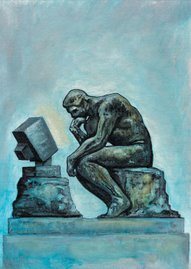These fallacies, also called fallacies of clearness, occur in arguments whose formulations contain ambiguous words or phrases, whose meanings shift and change more or less subtly in the course of the argument and thus render it fallacious.
Equivocation - a fallacy committed when the conclusion of the argument depends on the fact that one or more words are used, either explicitly or implicitly, in two different senses in the argument.
A law can be repealed by legislative authority. The law of gravity is a law. Therefore, the law of gravity can be repealed by the legislative authority.
To identify the fallacy of equivocation, look for reasoning that involves a shift between two or more sense of a key word or phrase in the argument.
Amphiboly – this fallacy occurs when the arguer misinterprets a statement that is ambiguous owing to some structural defect and proceeds to draw a conclusion based on this faulty interpretation.
John told Bob that he had made a mistake. It follows that John has at least the courage to admit his own mistakes
Professor Johnson said that he will give a lecture about heart failure in the biology lecture hall. It must be the case that a number of heart failures have occurred there recently.
Amphiboly differs from equivocation in two important ways: 1) the former involves a structural defect in a statement while the latter is always traced to an ambiguity in the meaning of one or more words; 2) the former involves a mistake made by the arguer in interpreting an ambiguous statement made by someone else, whereas in the latter the ambiguity is typically the arguer’s own creation.
Composition – a fallacy committed when the conclusion of an argument depends on the enormous transference of a characteristic from the parts of something onto the whole. In other words, the fallacy occurs when it is argued that because the parts have a certain characteristic, it follows that the whole has the characteristic, too, and the situation is such that the characteristic in question cannot be legitimately transferred from the parts to the whole.
It is sometimes called the part/whole fallacy because the arguer mistakenly concludes that the whole must have some characteristics because each part or member has that characteristic. The structure of this fallacy is: each member of W is f. Therefore, W is f. The assumption of the argument is that what is true of the part is true of the whole. This is often false especially in those cases which the whole is more than the sum of its parts.
A feather is light. Therefore, a plastic containing a billion feathers is light.
Each member of the orchestra is excellent, so the orchestra is excellent.
Each player on this basketball team is an excellent athlete. Therefore, the team as a whole is excellent.
To recognize the fallacy of composition, look for an argument that moves from a claim about the parts or members of a group to a conclusion about the whole. Consider then whether it is justifiable to attribute what is true of the parts to the whole.
Division – a fallacy that is the exact reverse of composition. As composition goes from parts to whole, division goes from whole to parts. The fallacy is committed when the conclusion of an argument depends on the erroneous transference of a characteristic from a whole onto parts. Its structure is: W is f. Therefore, each member of W is f.
Salt is a nonpoisonous compound. Therefore, its component elements, sodium and chlorine, are non poisonous.
he union voted to strike. Therefore, every member of the union voted to strike.
Humans are the only animals capable of philosophical thinking. Thus every person is capable of philosophical thinking.
To recognize the fallacy of division, look for an argument that moves from a claim about a whole group or a group to a conclusion about one or all of the members of the whole. Then consider whether it is justifiable to attribute what is true of the whole to its parts.
Accent – a fallacy that arises from the mistaken interpretation of a statement but the mistake is due to the ambiguity in the way the statement is spoken. It occurs when the arguer illegitimately stresses one or more words in the given statement and then proceeds to draw a conclusion based on the resultant interpretation.
Catherine said (she) did not (drive) (her) (car) (today). Therefore: 1. Somebody else must have driven it; 2. She may have washed it; 3. She must have driven someone else’s; 4. She must have driven her truck; 5. She must have driven it yesterday.
A variation of the fallacy of accent occurs when the person who makes the original statement entices the arguer into a certain misinterpretation and thereby tricks him into construction a fallacious argument.
[The chief mate did not drink yesterday] [The captain is sober today.]

Nuk ka komente:
Posto një koment